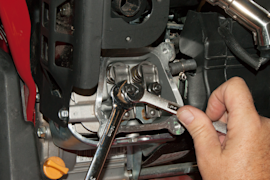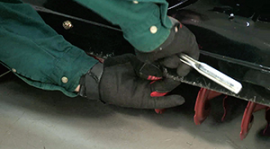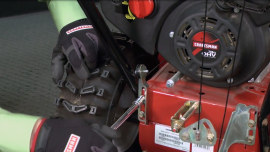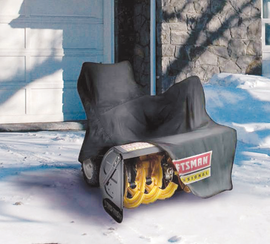- Kenmore refrigerator water filters
- Whirlpool refrigerator water filters
- Samsung refrigerator water filters
- GE refrigerator water filters
- LG refrigerator water filters
- Frigidaire refrigerator water filters
- KitchenAid refrigerator water filters
- Maytag refrigerator water filters
- Kenmore Elite refrigerator water filters
- Estate refrigerator water filters
- GE Profile refrigerator water filters
- Amana refrigerator water filters
- Bosch refrigerator water filters
- Dacor refrigerator water filters
- Electrolux refrigerator water filters
How to store a snowblower


Your snowblower worked hard all winter, battling the elements to keep your paths clear. Now, it’s time to give it a well-earned break. A little maintenance now ensures it fires up smoothly next winter, avoiding rust, fuel issues, and worn-out parts.
The best place to store a snowblower is in a dry garage or shed, where it’s safe from moisture and temperature extremes. If indoor storage isn’t an option, you can store it outside—just elevate it on blocks and cover it with a heavy-duty tarp to protect it from rain and snow.
For troubleshooting tips and step-by-step repairs, visit our snowblower repair help page.
Remove or Stabilize Snowblower Gas
Gas left in the tank can form deposits that clog fuel lines and the carburetor. Either remove it or stabilize it before storage.
To remove fuel, run the engine until it stalls. Drain any remaining gas into an approved container. Run the engine outdoors until it stops completely. Dispose of fuel properly.
To stabilize fuel, add stabilizer to fresh gas in a separate container. Pour the treated fuel into the tank and run the engine for 10 minutes to circulate it through the carburetor.
Change the Snowblower Engine Oil
For best engine performance, change the engine oil before storage. Start by running the engine for a few minutes to warm up the oil, making it easier to drain. Turn off the engine and remove the drain plug to let the old oil fully drain into an approved container. Replace the drain plug and refill the engine with fresh oil as specified in your owner’s manual.
To further protect the engine, lubricate the piston and cylinder. Remove the spark plug and pour a teaspoon of clean engine oil into the spark plug hole. Cover the hole with a clean shop towel and pull the starter cord several times to distribute the oil evenly inside the cylinder. Reinstall the spark plug securely.
Clean the Snowblower Thoroughly
Wash off salt, dirt, and debris from the auger blades, frame, and tires. Dry metal areas with a clean rag. Apply rust and corrosion spray to exposed metal surfaces.
Lubricate Snowblower Moving Parts
Apply lubricant to the drive gear shaft, wheel axles, chute control, and auger shaft as directed in the owner’s manual.
Tighten Snowblower Fasteners
Inspect and tighten nuts, bolts, and fasteners on the auger and chute. Secure cables and connections to prevent wear and tear.
Inspect and Repair Snowblower Components
Check for rust, damaged paint, and worn parts. Lightly sand rusted areas before applying touch-up paint. Replace worn-out components before storing the machine.
If you're having trouble replacing any parts, these step-by-step guides should help:
For more DIY repair tips and troubleshooting, visit our snowblower repair help page.
Cover and Store the Snowblower Properly
Use a heavy-duty snowblower cover or tarp. Store the machine in a dry garage or shed. If storing outdoors, elevate it on blocks and keep it fully covered.
Following these steps extends the life of your snowblower and ensures it's ready to go when the snow returns.
Symptoms for gas snowblowers
Choose a symptom to see related snowblower repairs.
Things to do: replace the spark plug, change the oil, rebuild the carburetor, adjust valve lash, adjust or replace the b…
Main causes: clogged chute, damaged auger blades, broken shear pins, worn auger belt, damaged gear case, engine problems…
Main causes: dirty carburetor, stale fuel…
Main causes: punctured tire, damaged rim…
Main causes: dirty carburetor, clogged fuel filter, dirty spark plug, incorrect valve lash, leaky engine gaskets…
Main causes: stale gas, clogged carburetor, clogged or broken fuel line, dirty spark plug, bad rewind starter, incorrect…
Main causes: loose drive clutch cable, damaged drive clutch cable, worn friction disc, scraper blade scraping the ground…
Main causes: snow build-up in chute, chute drive mechanism failure, bad chute control assembly…
Main causes: clogged chute, snow build-up in auger housing, broken auger shear pins, auger drive belt needs adjustment, …
Repair guides for gas snowblowers
These step-by-step repair guides will help you safely fix what’s broken on your snowblower.

How to adjust snowblower engine valve lash
Adjust the engine valve lash on your snowblower to keep the engine starting and running smoothly.…
Repair difficulty
Time required
15 minutes or less

How to adjust snowblower skid shoes
To prevent snowblower auger and shave plate damage, adjust the skid shoes regularly to keep the shave plate ¼-inch high.…
Repair difficulty
Time required
15 minutes or less

How to replace a snowblower shave plate
Follow the 7 easy steps in this repair guide/video to replace a worn out shave plate on your snowblower.…
Repair difficulty
Time required
15 minutes or less
Articles and videos for gas snowblowers
Use the advice and tips in these articles and videos to get the most out of your snowblower.

Find out how to clear chute obstructions, replace shear pins and adjust or replace your auger engagement cable if your s…

Find easy DIY tips to fix your snowblower when it won't start…

Protect your snowblower's engine and body by preparing it for after-season storage.…